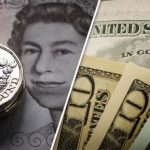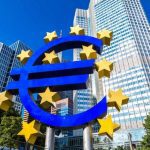TVC NEWS The euro dipped against the U.S. dollar on Thursday after European Central Bank chief Mario Draghi said policymakers did not discuss removing the bank’s easing bias on monetary policy, while the dollar jumped against the Swedish crown after the Riksbank extended its bond-buying.
The euro initially rose to a session high of $1.0932 EUR= on language in the ECB’s statement, read by Draghi, which said the euro zone’s recovery was increasingly solid and downside risks had diminished.
But other parts of the statement and Draghi’s replies to questions stressed the barriers the ECB still faces before beginning to tighten the ultra-loose financing conditions it has maintained for nine years.
Positive euro zone economic data and a Reuters report on Tuesday that many ECB rate-setters see scope for sending a small signal in June towards reducing monetary stimulus had lifted expectations for a less dovish stance.
“Draghi wasn’t hawkish enough, and the markets found that to be disappointing,” said Kathy Lien, managing director at BK Asset Management in New York.
The euro was last down 0.3 percent against the dollar at $1.0866, near a session low of $1.0852.
Sweden’s Riksbank extended its bond-buying and predicted its first interest rate hike in mid-2018, later than previously projected. That sent the dollar as much as 1.3 percent higher against the Swedish crown to a session peak of 8.8730 crowns per dollar SEK=.
The Bank of Japan also signaled it would maintain its massive stimulus effort, despite offering its most optimistic assessment of the Japanese economy in nine years.
Governor Haruhiko Kuroda conceded that public perceptions of future price increases remained subdued, which disappointed some traders hoping for a more hawkish inflation outlook and pushed the dollar higher against the yen.
“That lower inflation forecast would suggest continued accommodative monetary policy,” said Eric Viloria, currency strategist at Wells Fargo in New York.
The dollar was last 0.1 percent higher against the yen at 111.18 yen after rising as much as 0.5 percent to a session high of 111.59.
The dollar index .DXY, which measures the greenback against a basket of six major rivals, was last up 0.2 percent at 99.209.
The dollar was down 0.6 percent against the Mexican peso at 19.0560 pesos MXN= after U.S. President Donald Trump said he would not scrap the North American Free Trade Agreement (NAFTA).
TVC NEWS The euro dipped against the U.S. dollar on Thursday after European Central Bank chief Mario Draghi said policymakers did not discuss removing the bank’s easing bias on monetary policy, while the dollar jumped against the Swedish crown after the Riksbank extended its bond-buying.
The euro initially rose to a session high of $1.0932 EUR= on language in the ECB’s statement, read by Draghi, which said the euro zone’s recovery was increasingly solid and downside risks had diminished.
But other parts of the statement and Draghi’s replies to questions stressed the barriers the ECB still faces before beginning to tighten the ultra-loose financing conditions it has maintained for nine years.
Positive euro zone economic data and a Reuters report on Tuesday that many ECB rate-setters see scope for sending a small signal in June towards reducing monetary stimulus had lifted expectations for a less dovish stance.
“Draghi wasn’t hawkish enough, and the markets found that to be disappointing,” said Kathy Lien, managing director at BK Asset Management in New York.
The euro was last down 0.3 percent against the dollar at $1.0866, near a session low of $1.0852.
Sweden’s Riksbank extended its bond-buying and predicted its first interest rate hike in mid-2018, later than previously projected. That sent the dollar as much as 1.3 percent higher against the Swedish crown to a session peak of 8.8730 crowns per dollar SEK=.
The Bank of Japan also signaled it would maintain its massive stimulus effort, despite offering its most optimistic assessment of the Japanese economy in nine years.
Governor Haruhiko Kuroda conceded that public perceptions of future price increases remained subdued, which disappointed some traders hoping for a more hawkish inflation outlook and pushed the dollar higher against the yen.
“That lower inflation forecast would suggest continued accommodative monetary policy,” said Eric Viloria, currency strategist at Wells Fargo in New York.
The dollar was last 0.1 percent higher against the yen at 111.18 yen after rising as much as 0.5 percent to a session high of 111.59.
The dollar index .DXY, which measures the greenback against a basket of six major rivals, was last up 0.2 percent at 99.209.
The dollar was down 0.6 percent against the Mexican peso at 19.0560 pesos MXN= after U.S. President Donald Trump said he would not scrap the North American Free Trade Agreement (NAFTA).
TVC NEWS The euro dipped against the U.S. dollar on Thursday after European Central Bank chief Mario Draghi said policymakers did not discuss removing the bank’s easing bias on monetary policy, while the dollar jumped against the Swedish crown after the Riksbank extended its bond-buying.
The euro initially rose to a session high of $1.0932 EUR= on language in the ECB’s statement, read by Draghi, which said the euro zone’s recovery was increasingly solid and downside risks had diminished.
But other parts of the statement and Draghi’s replies to questions stressed the barriers the ECB still faces before beginning to tighten the ultra-loose financing conditions it has maintained for nine years.
Positive euro zone economic data and a Reuters report on Tuesday that many ECB rate-setters see scope for sending a small signal in June towards reducing monetary stimulus had lifted expectations for a less dovish stance.
“Draghi wasn’t hawkish enough, and the markets found that to be disappointing,” said Kathy Lien, managing director at BK Asset Management in New York.
The euro was last down 0.3 percent against the dollar at $1.0866, near a session low of $1.0852.
Sweden’s Riksbank extended its bond-buying and predicted its first interest rate hike in mid-2018, later than previously projected. That sent the dollar as much as 1.3 percent higher against the Swedish crown to a session peak of 8.8730 crowns per dollar SEK=.
The Bank of Japan also signaled it would maintain its massive stimulus effort, despite offering its most optimistic assessment of the Japanese economy in nine years.
Governor Haruhiko Kuroda conceded that public perceptions of future price increases remained subdued, which disappointed some traders hoping for a more hawkish inflation outlook and pushed the dollar higher against the yen.
“That lower inflation forecast would suggest continued accommodative monetary policy,” said Eric Viloria, currency strategist at Wells Fargo in New York.
The dollar was last 0.1 percent higher against the yen at 111.18 yen after rising as much as 0.5 percent to a session high of 111.59.
The dollar index .DXY, which measures the greenback against a basket of six major rivals, was last up 0.2 percent at 99.209.
The dollar was down 0.6 percent against the Mexican peso at 19.0560 pesos MXN= after U.S. President Donald Trump said he would not scrap the North American Free Trade Agreement (NAFTA).
TVC NEWS The euro dipped against the U.S. dollar on Thursday after European Central Bank chief Mario Draghi said policymakers did not discuss removing the bank’s easing bias on monetary policy, while the dollar jumped against the Swedish crown after the Riksbank extended its bond-buying.
The euro initially rose to a session high of $1.0932 EUR= on language in the ECB’s statement, read by Draghi, which said the euro zone’s recovery was increasingly solid and downside risks had diminished.
But other parts of the statement and Draghi’s replies to questions stressed the barriers the ECB still faces before beginning to tighten the ultra-loose financing conditions it has maintained for nine years.
Positive euro zone economic data and a Reuters report on Tuesday that many ECB rate-setters see scope for sending a small signal in June towards reducing monetary stimulus had lifted expectations for a less dovish stance.
“Draghi wasn’t hawkish enough, and the markets found that to be disappointing,” said Kathy Lien, managing director at BK Asset Management in New York.
The euro was last down 0.3 percent against the dollar at $1.0866, near a session low of $1.0852.
Sweden’s Riksbank extended its bond-buying and predicted its first interest rate hike in mid-2018, later than previously projected. That sent the dollar as much as 1.3 percent higher against the Swedish crown to a session peak of 8.8730 crowns per dollar SEK=.
The Bank of Japan also signaled it would maintain its massive stimulus effort, despite offering its most optimistic assessment of the Japanese economy in nine years.
Governor Haruhiko Kuroda conceded that public perceptions of future price increases remained subdued, which disappointed some traders hoping for a more hawkish inflation outlook and pushed the dollar higher against the yen.
“That lower inflation forecast would suggest continued accommodative monetary policy,” said Eric Viloria, currency strategist at Wells Fargo in New York.
The dollar was last 0.1 percent higher against the yen at 111.18 yen after rising as much as 0.5 percent to a session high of 111.59.
The dollar index .DXY, which measures the greenback against a basket of six major rivals, was last up 0.2 percent at 99.209.
The dollar was down 0.6 percent against the Mexican peso at 19.0560 pesos MXN= after U.S. President Donald Trump said he would not scrap the North American Free Trade Agreement (NAFTA).
TVC NEWS The euro dipped against the U.S. dollar on Thursday after European Central Bank chief Mario Draghi said policymakers did not discuss removing the bank’s easing bias on monetary policy, while the dollar jumped against the Swedish crown after the Riksbank extended its bond-buying.
The euro initially rose to a session high of $1.0932 EUR= on language in the ECB’s statement, read by Draghi, which said the euro zone’s recovery was increasingly solid and downside risks had diminished.
But other parts of the statement and Draghi’s replies to questions stressed the barriers the ECB still faces before beginning to tighten the ultra-loose financing conditions it has maintained for nine years.
Positive euro zone economic data and a Reuters report on Tuesday that many ECB rate-setters see scope for sending a small signal in June towards reducing monetary stimulus had lifted expectations for a less dovish stance.
“Draghi wasn’t hawkish enough, and the markets found that to be disappointing,” said Kathy Lien, managing director at BK Asset Management in New York.
The euro was last down 0.3 percent against the dollar at $1.0866, near a session low of $1.0852.
Sweden’s Riksbank extended its bond-buying and predicted its first interest rate hike in mid-2018, later than previously projected. That sent the dollar as much as 1.3 percent higher against the Swedish crown to a session peak of 8.8730 crowns per dollar SEK=.
The Bank of Japan also signaled it would maintain its massive stimulus effort, despite offering its most optimistic assessment of the Japanese economy in nine years.
Governor Haruhiko Kuroda conceded that public perceptions of future price increases remained subdued, which disappointed some traders hoping for a more hawkish inflation outlook and pushed the dollar higher against the yen.
“That lower inflation forecast would suggest continued accommodative monetary policy,” said Eric Viloria, currency strategist at Wells Fargo in New York.
The dollar was last 0.1 percent higher against the yen at 111.18 yen after rising as much as 0.5 percent to a session high of 111.59.
The dollar index .DXY, which measures the greenback against a basket of six major rivals, was last up 0.2 percent at 99.209.
The dollar was down 0.6 percent against the Mexican peso at 19.0560 pesos MXN= after U.S. President Donald Trump said he would not scrap the North American Free Trade Agreement (NAFTA).
TVC NEWS The euro dipped against the U.S. dollar on Thursday after European Central Bank chief Mario Draghi said policymakers did not discuss removing the bank’s easing bias on monetary policy, while the dollar jumped against the Swedish crown after the Riksbank extended its bond-buying.
The euro initially rose to a session high of $1.0932 EUR= on language in the ECB’s statement, read by Draghi, which said the euro zone’s recovery was increasingly solid and downside risks had diminished.
But other parts of the statement and Draghi’s replies to questions stressed the barriers the ECB still faces before beginning to tighten the ultra-loose financing conditions it has maintained for nine years.
Positive euro zone economic data and a Reuters report on Tuesday that many ECB rate-setters see scope for sending a small signal in June towards reducing monetary stimulus had lifted expectations for a less dovish stance.
“Draghi wasn’t hawkish enough, and the markets found that to be disappointing,” said Kathy Lien, managing director at BK Asset Management in New York.
The euro was last down 0.3 percent against the dollar at $1.0866, near a session low of $1.0852.
Sweden’s Riksbank extended its bond-buying and predicted its first interest rate hike in mid-2018, later than previously projected. That sent the dollar as much as 1.3 percent higher against the Swedish crown to a session peak of 8.8730 crowns per dollar SEK=.
The Bank of Japan also signaled it would maintain its massive stimulus effort, despite offering its most optimistic assessment of the Japanese economy in nine years.
Governor Haruhiko Kuroda conceded that public perceptions of future price increases remained subdued, which disappointed some traders hoping for a more hawkish inflation outlook and pushed the dollar higher against the yen.
“That lower inflation forecast would suggest continued accommodative monetary policy,” said Eric Viloria, currency strategist at Wells Fargo in New York.
The dollar was last 0.1 percent higher against the yen at 111.18 yen after rising as much as 0.5 percent to a session high of 111.59.
The dollar index .DXY, which measures the greenback against a basket of six major rivals, was last up 0.2 percent at 99.209.
The dollar was down 0.6 percent against the Mexican peso at 19.0560 pesos MXN= after U.S. President Donald Trump said he would not scrap the North American Free Trade Agreement (NAFTA).
TVC NEWS The euro dipped against the U.S. dollar on Thursday after European Central Bank chief Mario Draghi said policymakers did not discuss removing the bank’s easing bias on monetary policy, while the dollar jumped against the Swedish crown after the Riksbank extended its bond-buying.
The euro initially rose to a session high of $1.0932 EUR= on language in the ECB’s statement, read by Draghi, which said the euro zone’s recovery was increasingly solid and downside risks had diminished.
But other parts of the statement and Draghi’s replies to questions stressed the barriers the ECB still faces before beginning to tighten the ultra-loose financing conditions it has maintained for nine years.
Positive euro zone economic data and a Reuters report on Tuesday that many ECB rate-setters see scope for sending a small signal in June towards reducing monetary stimulus had lifted expectations for a less dovish stance.
“Draghi wasn’t hawkish enough, and the markets found that to be disappointing,” said Kathy Lien, managing director at BK Asset Management in New York.
The euro was last down 0.3 percent against the dollar at $1.0866, near a session low of $1.0852.
Sweden’s Riksbank extended its bond-buying and predicted its first interest rate hike in mid-2018, later than previously projected. That sent the dollar as much as 1.3 percent higher against the Swedish crown to a session peak of 8.8730 crowns per dollar SEK=.
The Bank of Japan also signaled it would maintain its massive stimulus effort, despite offering its most optimistic assessment of the Japanese economy in nine years.
Governor Haruhiko Kuroda conceded that public perceptions of future price increases remained subdued, which disappointed some traders hoping for a more hawkish inflation outlook and pushed the dollar higher against the yen.
“That lower inflation forecast would suggest continued accommodative monetary policy,” said Eric Viloria, currency strategist at Wells Fargo in New York.
The dollar was last 0.1 percent higher against the yen at 111.18 yen after rising as much as 0.5 percent to a session high of 111.59.
The dollar index .DXY, which measures the greenback against a basket of six major rivals, was last up 0.2 percent at 99.209.
The dollar was down 0.6 percent against the Mexican peso at 19.0560 pesos MXN= after U.S. President Donald Trump said he would not scrap the North American Free Trade Agreement (NAFTA).
TVC NEWS The euro dipped against the U.S. dollar on Thursday after European Central Bank chief Mario Draghi said policymakers did not discuss removing the bank’s easing bias on monetary policy, while the dollar jumped against the Swedish crown after the Riksbank extended its bond-buying.
The euro initially rose to a session high of $1.0932 EUR= on language in the ECB’s statement, read by Draghi, which said the euro zone’s recovery was increasingly solid and downside risks had diminished.
But other parts of the statement and Draghi’s replies to questions stressed the barriers the ECB still faces before beginning to tighten the ultra-loose financing conditions it has maintained for nine years.
Positive euro zone economic data and a Reuters report on Tuesday that many ECB rate-setters see scope for sending a small signal in June towards reducing monetary stimulus had lifted expectations for a less dovish stance.
“Draghi wasn’t hawkish enough, and the markets found that to be disappointing,” said Kathy Lien, managing director at BK Asset Management in New York.
The euro was last down 0.3 percent against the dollar at $1.0866, near a session low of $1.0852.
Sweden’s Riksbank extended its bond-buying and predicted its first interest rate hike in mid-2018, later than previously projected. That sent the dollar as much as 1.3 percent higher against the Swedish crown to a session peak of 8.8730 crowns per dollar SEK=.
The Bank of Japan also signaled it would maintain its massive stimulus effort, despite offering its most optimistic assessment of the Japanese economy in nine years.
Governor Haruhiko Kuroda conceded that public perceptions of future price increases remained subdued, which disappointed some traders hoping for a more hawkish inflation outlook and pushed the dollar higher against the yen.
“That lower inflation forecast would suggest continued accommodative monetary policy,” said Eric Viloria, currency strategist at Wells Fargo in New York.
The dollar was last 0.1 percent higher against the yen at 111.18 yen after rising as much as 0.5 percent to a session high of 111.59.
The dollar index .DXY, which measures the greenback against a basket of six major rivals, was last up 0.2 percent at 99.209.
The dollar was down 0.6 percent against the Mexican peso at 19.0560 pesos MXN= after U.S. President Donald Trump said he would not scrap the North American Free Trade Agreement (NAFTA).










